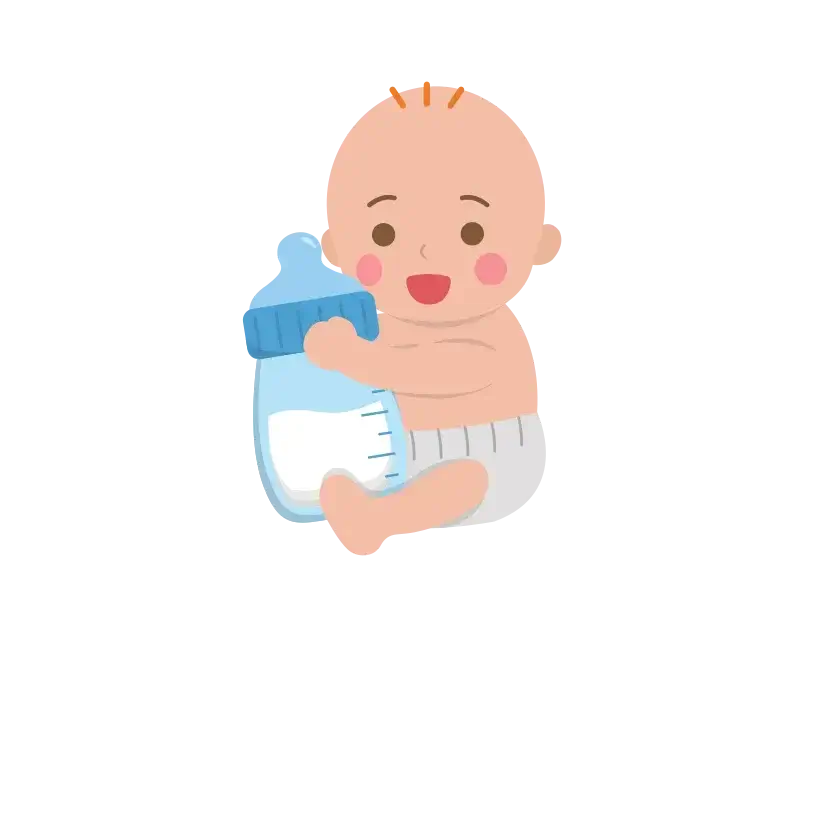Menu

A thrilling period unfolds at six months as your baby develops rapidly. Their brain’s left and right sides communicate, enhancing their body coordination. During this time, your baby becomes more expressive, conveying feelings of happiness or sadness and responding to spoken words.
By six months, babies acquire a heightened sense of self and their place in the world. They develop a clear distinction between parents, siblings, and others, potentially displaying signs of unease around unfamiliar faces. This stage marks a significant milestone in their awareness and understanding of the environment.
At this stage, your baby is actively exploring the world around them. They express joy through smiles, laughter, and engaging babble as a form of communication.
Mobility takes centre stage as your little one likely starts rolling onto their tummy and back, sits without assistance, and demonstrates the ability to support their weight, even bouncing when held.
This stage marks a delightful phase of interaction and physical development in your baby’s journey.
At six months, the average weight for a baby boy is 17 pounds, 8 ounces (7.9 kilograms), while a baby girl weighs 16 pounds, 2 ounces (7.3 kilograms).
In terms of height, a six-month-old baby boy measures around 26 1/2 inches (67.6 cm), while a girl measures approximately 25 ¾ inches long (65.7 cm).
Remember, these are just averages, and it’s perfectly normal if your baby doesn’t align precisely with these numbers. Every child develops at a unique pace, so focus on your little one’s growth journey rather than strict comparisons.
Teething typically commences around 6 to 12 months of age, although the emergence of the first teeth can vary, occurring either earlier or slightly later. In rare instances, newborns may be born with a tooth already visible or experience tooth eruption within the initial weeks of life.
Occasionally, a tooth may emerge without accompanying symptoms, whereas in other instances, teething symptoms might precede the visible appearance of the tooth by about three to four days.
As baby teeth progress and breach the gums, teething symptoms may manifest, including:
Irritability: Teething can lead to heightened irritability due to the discomfort associated with emerging teeth. Your baby may express this through increased fussiness, restlessness, or mood changes.
Drooling: The teething process stimulates saliva production, resulting in excessive drooling. You may observe your baby constantly drooling, sometimes leading to facial irritation. Keep a soft cloth handy to wipe their chin and mouth gently.
Swollen Gums: The gums surrounding emerging teeth may become red, swollen, and tender. Gentle pressure on the gums can offer relief through clean fingers or teething toys. Be cautious with teething rings to ensure they’re safe and appropriate for your baby’s age.
Chewing and Biting: Babies instinctively seek relief by chewing on objects. Provide teething toys made of safe materials or a clean, chilled teething ring. Be attentive to avoid anything small enough to pose a choking hazard.
Sleep Disturbances: Teething discomfort can disrupt your baby’s sleep patterns. They may struggle to settle down or wake up more frequently at night. Providing a comforting bedtime routine and using teething remedies before sleep can help ease their discomfort.
Refusing Food: Sore gums can make feeding uncomfortable. Your baby might exhibit a temporary aversion to eating, show less interest in nursing or bottle-feeding, or prefer softer foods during this period.
Cheek Rubbing and Ear Pulling: Teething pain can radiate to the cheeks and ears, prompting your baby to rub their cheeks or pull at their ears. This behaviour is a response to the discomfort in the jaw and gums.
The six-month milestone opens an exciting chapter in your baby’s diet. While maintaining breast milk or formula as a significant part of their nutrition, it’s time to introduce solid foods gradually. Cereals, fruits, and veggies, and especially softer options like bananas and avocados, make a smooth transition. Introduce one food at a time, watching for any signs of allergies.
As you venture into solid feeding, start with small amounts, around one ounce per feeding, and progress to about three ounces thrice daily. The goal is to acquaint them with various real foods gradually. Hold off on introducing whole milk until they reach the 12-month mark.
The American Academy of Family Physicians and The American Academy of Pediatrics recommend delaying the introduction of whole milk due to its high protein and mineral content, which may challenge your baby’s developing digestive system.
As your little one continues breastfeeding or consuming formula, they receive all the necessary nutrients for their growth and development. Be patient, observe their preferences, and enjoy this exciting phase of exploring new tastes and textures with your baby.
Are you wondering if your little one can start taking water? Certainly! Yes, it’s okay for your 6-month-old to have water, but it’s crucial not to give too much.
Excessive water intake can fill them up, potentially affecting the nutrients they get from breast milk, formula, or solid food.
Aim for a daily intake of four to eight ounces of water, ensuring they still receive adequate formula (up to 32 ounces per day) or breast milk (six to eight feedings per day). This balance ensures they get the essential nutrients while introducing them to drinking water.
Breast milk or formula remains crucial for your baby’s diet in the first year. However, as your baby approaches six months, it becomes appropriate to introduce solid foods alongside their primary milk source. These initial solid foods should look like the texture of breast milk or formula to ease the transition.
Opting for infant cereals or single-ingredient purees is ideal as they provide a slightly thicker consistency, allowing your baby to gradually adapt to the new eating experience while maintaining the nutritional balance of breast milk or formula.
This thoughtful introduction helps your baby explore different tastes and textures in a way that complements their familiar liquid diet.
Here are five steps to introduce solid foods to your 6-month-old for the first time:
When introducing solid foods to your baby around six months, consider starting with single vegetables and fruits.
Offer mashed or soft-cooked sticks of parsnip, broccoli, potato, yam, sweet potato, carrot, apple, or pear. Include non-sweet vegetables like broccoli, cauliflower, and spinach to expose your baby to various flavours, helping them develop a more diverse palate.
This approach may contribute to preventing fussiness with food as they grow. Ensure any cooked food has cooled before offering it to your baby.
Additionally, you can gradually introduce allergenic foods like peanuts, eggs, gluten, and fish from around six months, one at a time in small amounts, to monitor for potential reactions.
Once your baby begins eating solid foods, promote their engagement during mealtimes by encouraging them to touch, hold, and playfully explore food. Finger foods encompass a variety of options, including;
At six months, your baby will likely achieve more consistent nighttime sleep than in earlier stages. They typically take 2 to 3 naps during the day and sleep around 14 hours. This consists of approximately 10 hours at night and 4 hours during daytime naps.
These changes reflect a maturing sleep pattern, and variations in the exact sleep duration can be expected due to individual differences among babies. As your baby reaches this milestone, maintaining a regular sleep routine and responding to their cues can contribute to a more stable and restful sleep schedule.
The “wake window” is a crucial factor in your baby’s sleep routine, indicating the duration they can stay awake between naps. The appropriate wake window is essential because keeping your baby awake for the right amount of time increases the likelihood that they will fall asleep when you put them down for a nap.
Understanding and following their individual wake windows can contribute to a smoother and more effective naptime routine, aligning with your baby’s natural sleep patterns.
For babies between 4-6 months of age, the recommended wake window is 1.5 to 2.5 hours. Babies who are a little older, between 7-9 months, can stay awake for 2 to 3.5 hours before needing to doze off again.
Watch for signs of sleepiness in your baby to figure out the best time for naps. If they seem too tired after two hours, move nap time a bit earlier. If they’re not showing sleepiness, let them stay up a little longer, around 15 or 20 minutes.
Even if you diligently follow a 6-month-old sleep schedule, it’s important to recognise that your baby may not always fall asleep easily or sleep soundly through naps or the night. Babies are unique, and their sleep patterns can vary.
To help improve your baby’s sleep, here are a few practical tips you can implement immediately and continue using in the months ahead.
Create Bedtime and Nap Time Routines: Establish consistent bedtime and nap time routines to signal when it’s time to sleep. This can include activities like a warm bath, a short story, or gentle rocking, providing a predictable structure for your baby.
Keep the Crib Safe: Ensure the crib is a safe sleep environment. Remove loose bedding or toys, and place your baby on their back to sleep. Avoid using crib bumpers or other unnecessary items.
Understand Your Baby’s Sleep Cues: Pay attention to your baby’s cues that indicate they’re tired. These may include rubbing their eyes, yawning, or becoming less engaged with their surroundings. Responding to these cues helps you put them down to sleep at the right time.
Ensure Your Baby Isn’t Hungry: Make sure your baby isn’t hungry before putting them to sleep. A well-fed baby is more likely to sleep comfortably. Consider incorporating a feeding into your bedtime routine.
Engage Your Baby While They’re Awake: Keep your baby engaged and active during their awake times. This can include interactive play, tummy time, and other stimulating activities. A good balance of activity during the day can contribute to better sleep at night.
Use Safe Sleep Practices: Follow safe sleep practices, such as placing your baby on their back to sleep, using a firm mattress, avoiding soft bedding and offering a pacifier at bedtime. These practices reduce the risk of Sudden Infant Death Syndrome (SIDS) and create a safe sleep environment.
By now, your six-month-old baby’s senses are sharpening. Let’s explore each of the five senses.

By six months, your baby’s vision improves significantly, allowing them to see objects from a greater distance with sharper clarity. Encourage visual development by offering colorful toys and stimulating items in their surroundings.

Around six months, your baby begins recognising familiar sounds and voices, showing curiosity by turning to new or loud noises. Reading to your baby is essential now, as it helps develop language skills by exposing them to different sounds and rhythms, to support communication and understanding.

As your baby grows, their interest in touch extends beyond feeling your skin and your partner’s. Now, they’re intrigued by exploring new objects and surfaces. Encourage this curiosity by letting them touch various textures with their tiny hands.

Your baby’s sense of smell grows rapidly around six months. They’re becoming familiar with new scents alongside breast milk and clothing fragrances. This aligns with introducing solid foods, usually between four and six months. It’s typical for them to prefer certain foods as their taste develops. Introducing diverse flavors now can shape their palate and encourage a varied diet.

By six months, your baby’s vision improves significantly, allowing them to see objects from a greater distance with sharper clarity. Encourage visual development by offering colorful toys and stimulating items in their surroundings.

Around six months, your baby begins recognising familiar sounds and voices, showing curiosity by turning to new or loud noises.
Reading to your baby is essential now, as it helps develop language skills by exposing them to different sounds and rhythms, to support communication and understanding.

As your baby grows, their interest in touch extends beyond feeling your skin and your partner’s. Now, they’re intrigued by exploring new objects and surfaces. Encourage this curiosity by letting them touch various textures with their tiny hands.

Your baby’s sense of smell grows rapidly around six months. They’re becoming familiar with new scents alongside breast milk and clothing fragrances.
This aligns with introducing solid foods, usually between four and six months. It’s typical for them to prefer certain foods as their taste develops. Introducing diverse flavors now can shape their palate and encourage a varied diet.
Identifying pain in infants can be challenging since they can’t express themselves verbally. Nevertheless, they often exhibit distinct behavioural changes when experiencing discomfort. Common signs include
These milestones collectively demonstrate your baby’s developing physical, cognitive, and social abilities. Remember that each baby progresses at their own pace, and variations in reaching these milestones are normal.

At six months, tummy time becomes more enjoyable as your baby develops stronger neck and upper body muscles. They may start to lift their head and show increased curiosity during this activity.

When your baby reaches to be picked up, it goes beyond a physical action. This behaviour is a social and emotional milestone, indicating attachment and a desire for closeness with caregivers. It reflects their growing understanding of social interactions.

The ability to respond to their name at six months is a noteworthy cognitive achievement. It demonstrates a heightened awareness of identity and language development. Your baby is beginning to associate sounds with specific individuals and is responsive to familiar cues.

While not all babies crawl at six months, those displaying early signs, such as rocking back and forth or attempting forward movement, begin their journey of exploration and mobility. This stage sets the groundwork for more coordinated movement in the coming months.

Achieving longer, more consolidated sleep patterns at night is a significant milestone for both the baby and parents. While not all babies consistently sleep through the night, the extension of sleep duration indicates growing self-soothing abilities and a maturing sleep routine.

This milestone signifies the refinement of fine motor skills. Your baby’s ability to grasp and manipulate small objects such as toys, with their fingers showcases increased coordination and agility. They use this newfound skill to actively explore and engage with their environment, promoting cognitive development.

The ability to hold a bottle reflects growing hand strength and coordination. This development is a crucial step toward self-feeding independence. It empowers your baby to actively participate in their feeding routine actively, fostering a sense of autonomy.

When your baby grabs their feet and brings them to the mouth, it’s more than a physical action. This behaviour is a sign of developing body awareness and flexibility. Additionally, it can serve as a self-soothing mechanism, providing comfort and security.

The capacity to adjust their body to gain a better view of interesting objects highlights improving motor control and a growing sense of curiosity. They can turn their head from side to side and look up or down. These movements indicate your baby’s expanding visual exploration, contributing to cognitive development and spatial awareness.

Recognition of familiar faces, particularly those of their parents, showcases growing social awareness and attachment. Your baby’s ability to differentiate and respond to their parents contributes to developing secure and trusting relationships.

At six months, tummy time becomes more enjoyable as your baby develops stronger neck and upper body muscles. They may start to lift their head and show increased curiosity during this activity.

When your baby reaches to be picked up, it goes beyond a physical action. This behaviour is a social and emotional milestone, indicating attachment and a desire for closeness with caregivers. It reflects their growing understanding of social interactions.

The ability to respond to their name at six months is a noteworthy cognitive achievement. It demonstrates a heightened awareness of identity and language development. Your baby is beginning to associate sounds with specific individuals and is responsive to familiar cues.

While not all babies crawl at six months, those displaying early signs, such as rocking back and forth or attempting forward movement, begin their journey of exploration and mobility. This stage sets the groundwork for more coordinated movement in the coming months.

Achieving longer, more consolidated sleep patterns at night is a significant milestone for both the baby and parents. While not all babies consistently sleep through the night, the extension of sleep duration indicates growing self-soothing abilities and a maturing sleep routine.

This milestone signifies the refinement of fine motor skills. Your baby’s ability to grasp and manipulate small objects such as toys, with their fingers showcases increased coordination and agility. They use this newfound skill to actively explore and engage with their environment, promoting cognitive development.

The ability to hold a bottle reflects growing hand strength and coordination. This development is a crucial step toward self-feeding independence. It empowers your baby to actively participate in their feeding routine actively, fostering a sense of autonomy.

When your baby grabs their feet and brings them to the mouth, it’s more than a physical action. This behaviour is a sign of developing body awareness and flexibility. Additionally, it can serve as a self-soothing mechanism, providing comfort and security.

The capacity to adjust their body to gain a better view of interesting objects highlights improving motor control and a growing sense of curiosity. They can turn their head from side to side and look up or down.
These movements indicate your baby’s expanding visual exploration, contributing to cognitive development and spatial awareness.

Recognition of familiar faces, particularly those of their parents, showcases growing social awareness and attachment. Your baby’s ability to differentiate and respond to their parents contributes to developing secure and trusting relationships.
If your six-month-old baby shows signs of a developmental delay, seeking medical advice is crucial. Look out for the following indicators and schedule a visit to the doctor’s office if you observe any concerns:
Always trust your instincts as a parent. If you have doubts or notice unusual behaviours, seeking guidance from your pediatrician is essential. Regular check-ups allow you to discuss your baby’s development, and your pediatrician can offer guidance and address any concerns.
Be persistent, as your baby might take a few weeks to learn self-soothing and fall asleep independently. Stay committed, and soon, you’ll experience peaceful and quiet nights for everyone.
To alleviate teething discomfort in your baby,
Babies can start consuming water around six months, typically 4 to 8 ounces daily. Before this, they received sufficient fluids from formula or breast milk. Don’t stress if your baby doesn’t drink much water; offer it in a cup and let them decide how much, if any, they want to drink.
Around two-thirds of 6-month-old babies can sleep through the night, logging about 10 hours at night and approximately 4 hours during the day. Occasionally, a baby who has been sleeping through the night might experience disruptions due to new skills, teething, or separation anxiety.
Keep your six-month-old engaged with various activities, including play gyms, storytime, gentle bouncing, peek-a-boo, clapping, nursery rhymes, imitation games, and playing with bubbles to promote both entertainment and development.
Be persistent, as your baby might take a few weeks to learn self-soothing and fall asleep independently. Stay committed, and soon, you’ll experience peaceful and quiet nights for everyone.
To alleviate teething discomfort in your baby,
Babies can start consuming water around six months, typically 4 to 8 ounces daily. Before this, they received sufficient fluids from formula or breast milk. Don’t stress if your baby doesn’t drink much water; offer it in a cup and let them decide how much, if any, they want to drink.
Around two-thirds of 6-month-old babies can sleep through the night, logging about 10 hours at night and approximately 4 hours during the day. Occasionally, a baby who has been sleeping through the night might experience disruptions due to new skills, teething, or separation anxiety.
Keep your six-month-old engaged with various activities, including play gyms, storytime, gentle bouncing, peek-a-boo, clapping, nursery rhymes, imitation games, and playing with bubbles to promote both entertainment and development.
1. American Academy of Pediatrics: Nutrition
2. American Academy of Pediatrics: Recommended Drinks for Children Age 5 and Younger.
3. Center for Disease Control and Prevention: Data Table of Infant Weight-for-age Charts
4. Center for Disease Control and Prevention: Data Table of Infant Length-for-age Charts
5. Mayoclinic: Infant and toddler health
6. Newton: 6-month-old sleep schedule: sample schedule and expert tips
7. Your baby’s: first solid foods
© Mindsmaking 2024